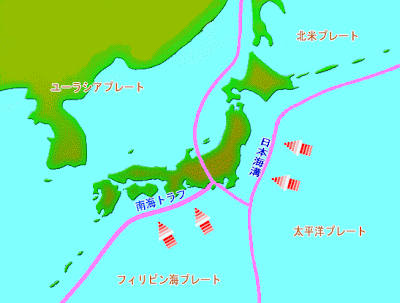The Tokyo Prefecture Office has issued a map of Tokyo indicating a degree of danger on occurrence of an expected earthquake for each street, district and ward.

Tokyo Town/Street Hazard Ranking (the scale bar unit: km)
http://kenplatz.nikkeibp.co.jp/article/building/news/20130110/598309/?P=3&rt=nocnt
It is called the ranking of danger. Red indicates the most dangerous; blue the second most dangerous and so on.
In January 2012, a study team of the University of Tokyo issued their prediction about a coming local earthquake under the Tokyo Metropolitan Area the possibility of which is "about 70% within four years!"
This Tokyo local earthquake is thought to kill 11,000 citizens and injure 210,000 residents while destroying 300,000 houses and buildings.
They think that there are 18 types of near-field earthquakes for Tokyo. Among them the one which is expected to cause the largest casualties is a local earthquake which has its epicenter at the estuary of the Arakawa River near the Tokyo Disney Resort Facilities. It will have a magnitude of M7.3 and shook Tokyo at maximum strength of 6 (shindo, a Japanese scale). It is called the "North of Tokyo Bay Earthquake."
But in a wider scope, the Kanto Plain on which Tokyo is situated is, as a whole, not safe at all.
The red zones are expected to have a degree-7 tremor; the brown zones a degree-6+; the yellow a degree of 6-, and so on.
By analyzing active fault faces under the ground, they have made clear where in the Kanto Plain would be the most susceptible to an earthquake.
http://www.eri.u-tokyo.ac.jp/daidai/exabs_koketsu.htm
The zones colored purple have a higher possibility of occurrence of an earthquake. The zones surrounded by dark-blue ellipses have a less possibility of an earthquake.
The zones colored purple have a higher possibility of occurrence of an earthquake. The zones surrounded by dark-blue ellipses have a less possibility of an earthquake.
An M9.0 earthquake occurred under the Pacific Ocean 400 km northeast of Tokyo in 2011. This situation resembles the one observed 1,100 years ago in Japan. At the time, namely in the ninth century, earthquakes and eruptions of volcanoes occurred in a concentrated manner during 30 years or so. Even Mt. Fuji erupted, and afterwards a big earthquake was triggered on the coastal areas facing the Pacific Ocean in the southwest of Tokyo.
So, some scientists in Japan predict that Tokyo will experience three more big earthquakes in near future. An M7 earthquake will occur under Tokyo; an M8 or M9 will occur in the Pacific coast areas between Tokyo and Nagoya; and an M8 class of an earthquake will occur in the Boso Peninsula in the southeast of Tokyo Bay, according to their study.
Anyway Japan is a place where 10% of global earthquakes occur. You cannot complain if you are attacked by a big earthquake in Japan if it is during the 2020 Tokyo Olympics.
Earthquakes Marked with Red Circles Having a Magnitude of 4 or More
http://ameblo.jp/galu999/entry-10886128929.html
Earthquakes Marked with Red Circles Having a Magnitude of 4 or More
http://ameblo.jp/galu999/entry-10886128929.html
Anyway there are no such capitals of nations in the world that are so dangerous as Tokyo.
In addition Japan has about 50 nuclear reactors for electricity generation though all of them are now halted due to fear of nuclear accidents (and periodic inspections) which has been intensified after the 2011 (ongoing) Fukuhsima Daiichi Nuclear Accident..
In addition Japan has about 50 nuclear reactors for electricity generation though all of them are now halted due to fear of nuclear accidents (and periodic inspections) which has been intensified after the 2011 (ongoing) Fukuhsima Daiichi Nuclear Accident..
Finally, this unique feature of Japan is of course due to continental plates moving toward certain directions on the earth. You cannot resist this power of the nature.
http://www.city.sakaide.lg.jp/site/bousai/jisin1.html
http://www.city.sakaide.lg.jp/site/bousai/jisin1.html
Yes, Tokyo






